Live on the homepage now!
Reader Supported News
And they don’t stop there, suggesting Britain and the U.S. would be targeted in a looming WWIII.
On the state TV show 60 Minutes, host Olga Skabeeva announced: “I have some unpleasant news... Even though we are methodically destroying the weapons that are being delivered [to Ukraine], but the quantities in which the United States are sending them force us to come up with some global conclusions. Perhaps it’s time to acknowledge that maybe Russia’s special operation in Ukraine has come to an end, in a sense that a real war had started: WWIII. We’re forced to conduct the demilitarization not only of Ukraine, but of the entire NATO alliance.”
Vladimir Avatkov, from the Diplomatic Academy of the Ministry of Foreign Affairs, said: “You mentioned WWIII and the way Americans and Poles are acting on the territory of Ukraine—indeed, we need to remember the words of Vladimir Vladimirovich Putin, who said that anyone who tries to interfere in the special military operation will pay a heavy price.” Skabeeva interrupted: “We never forget about these words of Vladimir Vladimirovich Putin, but a great number of people are already standing in line, trying to interfere in Russia’s special operation on the territory of Ukraine. Turns out, we have to act—but we’re yet to figure out how we can act without conducting a nuclear strike.”
Russian parliament member Oleg Matveychev weighed in: “If Poland starts any intervention... its current borders will be worthless.” Skabeeva wasn’t satisfied: “I wasn’t talking just about Poland, but mainly about Great Britain and the United States... they’re all lined up.” Avatkov chimed in: “No need to rush, there is a line. Everything in its time!”
The first in line is apparently Poland, with Secretary of the Russian Security Council Nikolai Patrushev baselessly claiming on Tuesday that Poland is moving to seize territories in western Ukraine and accusing numerous unnamed countries of “actively working to dismember Ukraine.” Meanwhile, on Russian state TV hosts and pundits routinely refer to Ukraine as “the territory formerly known as Ukraine” and matter-of-factly discuss how many millions of Ukrainians might have to die for Russia to complete its so-called “denazification.” In his recent interview, Russian State Duma Deputy Defense Committee Chairman Vladimir Shamanov, former Commander-in-Chief of the Russian Airborne Troops, admitted that Russia “was built through territorial enlargement” and named Poland as one of Russia’s main adversaries.
Appearing on the state TV show Sunday Evening With Vladimir Solovyov, Chairman of the State Duma Committee on Defense Andrey Kartapolov expounded on the idea of Russia’s crusade against the Western world: “For us, the special military operation is just the first act, an introduction. The war that is going on right now... it’s not just an economical war and info-war, this war is about our faith. It’s about our right, as the people, to have faith in what we want to believe, to love those we want to love, and to live the way our ancestors would have wanted, on our land and by our birthright.”
Kartapolov added: “These wars are not the first wars. In the 19th century—Napoleon, in the 20th century—Adolf Aloisovich Hitler, and every time all of Europe came at us. The same thing is happening now... It’s a good thing that a realization is coming, it’s time to stop lying. Stop lying to ourselves, stop lying to our leader, stop lying to our own people. It’s time to be responsible for our words and deeds and to move forward as one—to the goal that has been set by the commander-in-chief.”
The strategy of justifying such a potential attack against additional adversaries is consistent with the Kremlin’s previous approach with respect to Ukraine: ludicrous claims that the chosen target was about to go on the offensive against the Motherland. The impending conflict against the West is being framed in terms of an existential battle for Russia’s survival.
Kartapolov claimed, “Today, Europe is a de-facto colony of the United States, the new type of a colony. In the ’90s, we were the same kind of a colony but managed to break free—thanks to our president and the decisions he made... They put everything in a beautiful wrapper, selling it to us under the guise of democracy, freedom of speech and all sorts of other slogans. Their main goal was to usurp our resources, our natural resources, to split Russia up into many vicious countries fighting with one another.”
The alleged desire to “dismember Russia” is also being ascribed to opposition activists, in order to simultaneously target all perceived enemies, both foreign and domestic. During Monday’s broadcast of The Evening With Vladimir Solovyov, arguments were made to limit the influence of members of the opposition on Russian society—particularly those who still travel abroad. Political scientist Vadim Gigin claimed, “People who are planning to return to Russia... are proposing to divide the country.” Host Vladimir Solovyov added, “They have the lists of undesirables... they’ll be hanging people. What’s scary is that they’re coming back.”
Shota Gorgadze, a member of the Russian Presidential Human Rights Council proposed that immediately upon their return, opposition activists be criminally charged for their alleged calls to dismember Russia. Agitated, Solovyov complained, “For months we’ve been demanding that criminal cases be open against all of [Alexei] Navalny’s terrorist sect under article 275 [treason].” Gorgadze proposed that anyone speaking out “against the interests of the Russian Federation, especially during this difficult time” be stripped of their Russian citizenship. He added, “If the law says this can’t be done, I don’t see any reason why this law can’t be changed.”
Urging a more aggressive approach, Solovyov asked, “Are we acting as inert gases, simply taking up only as much room as the West allows? The West is squeezing us and we’re accepting it and adapting to it? When things let up, will we exhale and welcome the air of freedom? No, that won’t work. It’s time to sober up and find our way.”
Discussing Russia’s confrontation with the collective West during Sunday Evening With Vladimir Solovyov, Kartapolov framed it as a crusade: “I’m convinced that this war is about faith. Russia is an Orthodox country, and by “Orthodox” I don’t mean just Christianity. Orthodoxy is when on our territory all traditional religions peacefully co-exist: traditional Islam, Buddhism, and Judaism... They’re saying, we’re destroying the Ukrainian culture. What culture? Look at the devils they pulled out from the basements of Azovstal... It’s the face—I can’t even call it a face—the snout of the unclean. The holy scripture says, “What has been will be again, what has been done will be done again; there is nothing new under the sun.” In the 19th century, we came to Paris, in the 20th century we came to Berlin—we’ll come wherever they try to enslave and humiliate us. You won’t succeed. Expect us.”
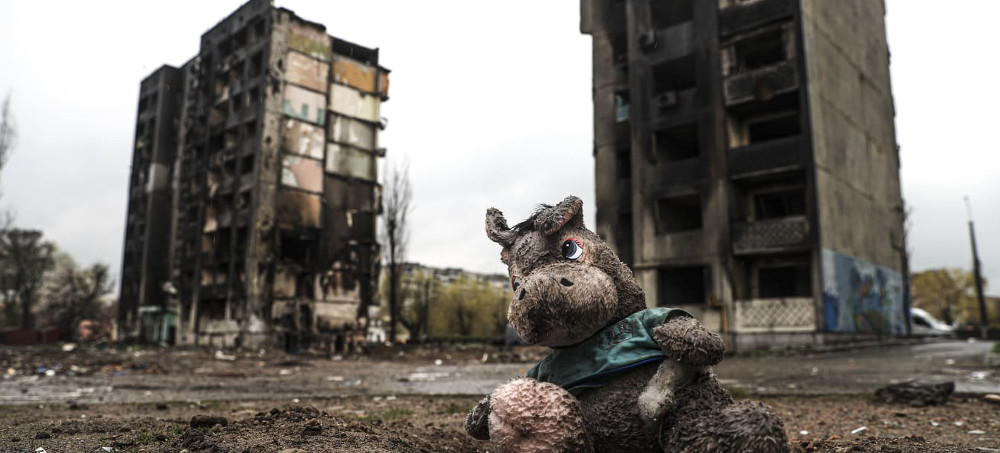 An average of two children per day are being killed by the war in Ukraine. (photo: Anadolu Agency)
An average of two children per day are being killed by the war in Ukraine. (photo: Anadolu Agency)
The Russian leader put on a deranged show of heroics to mark the international children’s holiday, even as an average of at least two kids a day are being killed in his war.
“On the day for the protection of children, it’s impossible not to remember the children in the Donbas, who have been subjected to lethal dangers for eight years,” the Russian leader said during a video conference with families.
In keeping with the Kremlin’s tried-and-tested propaganda, he put the blame for the children’s suffering squarely on Ukrainian forces, blaming the “Kyiv regime” for the many children killed and injured, despite overwhelming evidence of a deliberate campaign by his own troops to target civilian families in a bid to crush Ukrainian resistance since the all-out invasion on Feb. 24.
“Many [children] lost their parents, and there are some who have been left completely without families. We will do everything to guarantee them all measures of social support. … And, of course, we will help children who’ve lost their loved ones to obtain the same loving, friendly, and generous families as yours,” he told the Russian families in attendance.
Putin’s comments were jarring enough in light of the more than 240 Ukrainian children prosecutors there say have been killed since Moscow’s soldiers launched an all-out war on Feb. 24, but they seemed all the more nauseating since Ukrainian authorities revealed Tuesday that more than 243,000 kids have been forcibly removed from the country—and many of them separated from their parents in Russia.
That staggering figure was announced at a briefing Tuesday by Daria Gerasimchuk, adviser to the Ukrainian president’s commissioner for children’s rights, according to local media reports.
“Russia is mercilessly taking away lives and destroying futures, maiming and raping, making orphans of our youngest generation,” Ukraine’s Prosecutor General, Iryna Venediktova, wrote in a statement on Facebook to mark the holiday.
She said the forced deportation of thousands of Ukrainian children to Russia was part of authorities’ war crimes investigation, as it is “direct evidence of a plan to destroy the nation.”
“From the testimony of those who have saved themselves, we know about these horrors that Russian troops are forcibly transporting people to Russia, where the children are separated from their mothers. They then send the mothers to Sakhalin, and the children to other cities. Is this really the 21st century?” Venediktova wrote.
Ukrainian authorities said earlier this month that about 2,000 of the Ukrainian children taken to Russia were orphans who Russian authorities planned to adopt out to local families. Ukraine’s Foreign Affairs Ministry has said some of those forcibly deported to Russia for potential “illegal” adoptions were children whose parents were killed at the hands of Putin’s troops.
UNICEF also provided a sobering counterpoint to Putin’s disturbing show of supposed graciousness Tuesday, saying in a statement on the eve of the holiday that at least two children in Ukraine are being killed each day, “mostly in attacks using explosive weapons in populated areas.”
“Nearly 100 days of war in Ukraine have wrought devastating consequences for children at a scale and speed not seen since World War II,” UNICEF said.
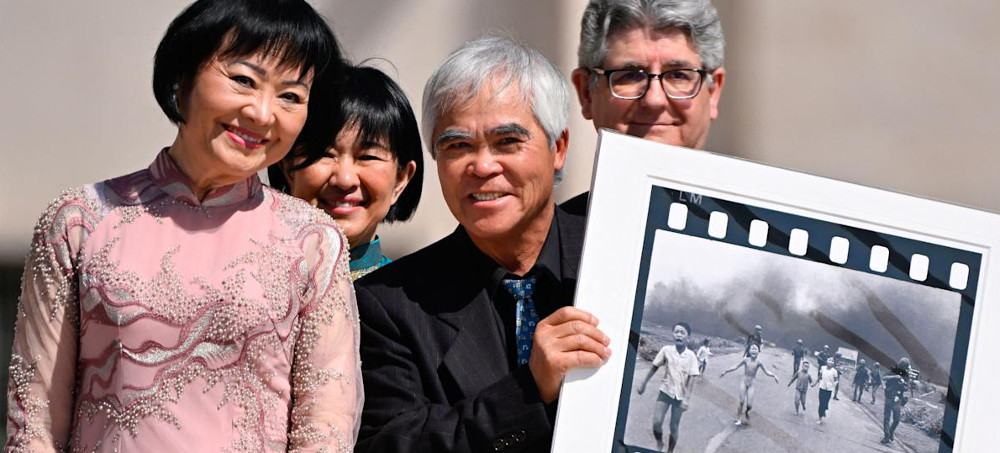 Photographer Nick Ut holds his 1972 photograph alongside Kim Phuc as they attend Pope Francis' weekly open-air general audience in St.Peters' square on May 11, 2022, at the Vatican. (photo: Alberto Pizzoli/Getty)
Photographer Nick Ut holds his 1972 photograph alongside Kim Phuc as they attend Pope Francis' weekly open-air general audience in St.Peters' square on May 11, 2022, at the Vatican. (photo: Alberto Pizzoli/Getty)
The single searing image didn't just change the youngster's life. After landing on the front page of numerous international newspapers, it changed the world and altered the course of the Vietnam War.
On June 8, 1972, Phuc was a 9-year-old growing up in the shadow of the Vietnam War when a sudden and deadly napalm bomb dropped from overhead on the tiny village of Trang Bang. The aerial attack by South Vietnamese Air Force Skyraiders singed her small body, sending her screaming down Highway 1 after ripping off her clothes, while flanked by her brothers and cousins. The pain of her stark naked silhouette pleading in agony is palpable.
If not for a plucky 21-year-old photographer, the gut-wrenching moment could have been lost to history, and Phuc could have lost her life.
The singular image, officially titled "The Terror of War," but colloquially known as "Napalm Girl," transformed both their lives and forged what would become a lifelong bond between photographer and subject. But every step in the path to publishing the iconic Pulitzer Prize-winning image was heart-stopping.

A photograph snapped — and a life saved
Nick Ut, also Vietnamese, was an AP photographer working the bloody war for years — with multiple near-death experiences.
After taking the photo, he saw Phuc's grave distress — her skin was coming off as she wailed "I'm dying" — and sprung into action. "I look at Kim and the children, and I couldn't leave her to die," Ut told Insider. He personally delivered her to the hospital, using his media muscle to ensure she receive medical attention from the overwhelmed medical staff. (She was placed in a morgue after being written off as too injured to survive.)
Ut not only captured the tragic toll of war on innocents, but he saved the young girl's life. Yet the world was almost deprived of seeing that particular bitter moment of war.
"They said, 'I don't think we can use it,'" he recalled of some editors who asked him to retouch the visceral image because of the nudity. But the original image ran intact, leading to much hand-wringing about US involvement, and helping to usher the end of the 20-year battle some two years later.

Phuc was forever grateful. "He is my hero. I owe him — for the way that he not only took my picture, but for saving my life. He put down his camera and brought me to the hospital."
Ut felt the same way.
"After I took Kim's photos, I saved her life, and I wanted Kim to be like family," Ut, 71, told Insider. It would be another 17 years before they would reunite — with Ut fleeing post-war Vietnam and Phuc "stuck" there — but the connection was unbreakable. At their meeting in Cuba where she was studying medicine, Phuc longed to tell her beloved "Uncle Ut" how she yearned to flee their homeland like he did. He fled in 1975 after the fall of Saigon and moved to LA two years later, in 1977.
But surveillance by the embassy forced a superficial confab. "I wanted to scream, 'Uncle Ut, help me,' but I knew we'd be in trouble," said Phuc, noting that after safely defecting to Canada in 1992, Ut could finally say to her, "I'm so happy you have freedom."
Both photographer and subject ended up in North America, and stayed close despite the distance
Granted political asylum thousands of miles from her oppressive homeland, she settled near Toronto with her Vietnamese husband and went on to become a mom of two boys and a globe-trotting UNESCO Goodwill Ambassador.
Ut married and had two children, putting down roots in Hollywood and shooting for the AP for decades. The camera he used to shoot Phuc, a Leica M2 with 35-mm. f2 lens, was left for history in a museum in Washington.
"When I got freedom in Canada I wanted to escape that picture," said Phuc, whose feelings of sadness and hope often mingled. "I didn't like being that little girl in that picture at all," she said. "I didn't feel like my life belonged to me."
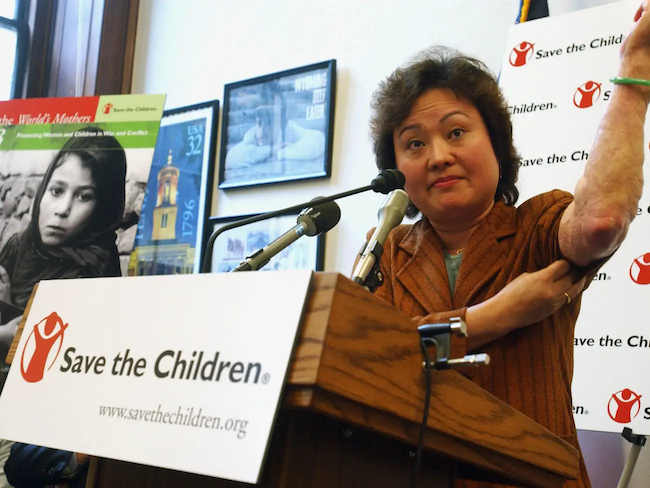
As much as her outward identity was shaped by "Napalm Girl," Phuc, who's been through 17 operations and 11 laser treatments, strived to cultivate her own personal constitution on her own terms.
But a new perspective evolved from freedom and motherhood. "I have freedom and I can protect children around the world," she said. For all its horror and humanity, Phuc made peace with the photo and all it represented, with anger giving way to acceptance — and ultimately gratitude: "I went back to embrace that picture and work with it for peace. That moment became a powerful gift for me."
An image with a lasting impact
The impact and resonance of the photo was felt for decades. "Vietnam War veterans said to me, 'I came home early because of your picture. I didn't want to die in Vietnam,'" Ut recalled of being approached in public over the years.
The image captures how children suffer in warfare, and also the horrifying effects of napalm, a flammable jelly-like substance developed by a US chemist that when ignited burns through skin and tissue, inflicting lifelong disfigurement and suffering on those it does not kill. The US and South Vietnam used napalm extensively to set fire to North Vietnamese and Viet Cong fighters and their often concealed routes. But concerns about its terrifying effects persuaded the US to destroy its stocks and agree in 2009 not to use it and other incendiaries except against military targets.
Ut and Phuc would go on to visit the Vietnam War Memorial together in Washington and meet the Queen Elizabeth some 20 years ago. This month they had an audience with the Pope, who was given a signed, framed photo of "Terror of War."
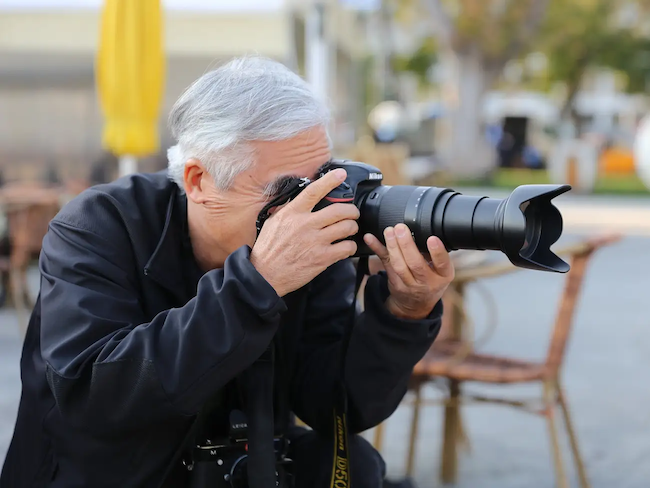
Amidst a recent controversy around the photo, when Facebook briefly removed it for violating its standards in 2016, Phuc fought back, insisting on the image as a force for good. "I gave a statement. I say, 'That picture is not the way you think. That picture records the moment and shows the horror that children suffer.'"
It was reinstated shortly later.
As the seminal 50th anniversary nears, it's a mix of complicated emotions while taking stock of their lives and the world. Phuc and Ut will appear together in NYC at Fotografiska Museum to discuss iconic war photography etched in the public consciousness before friends and colleagues.
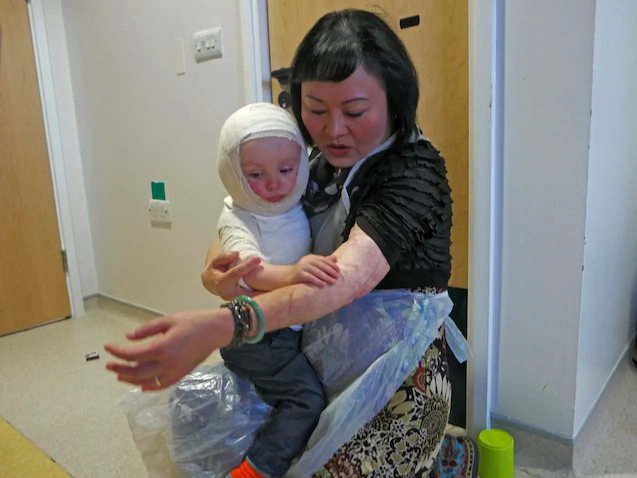
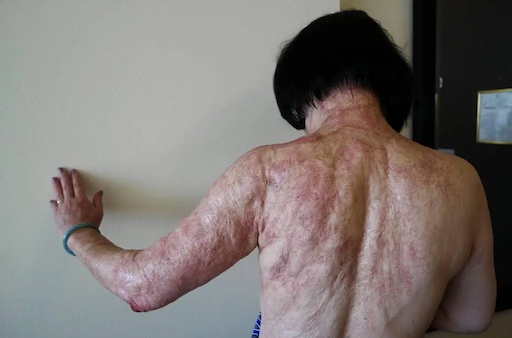
Her hard-won lessons of survival are more relevant today than ever. As images from Ukraine emerge, including a parade of images of children injured and fleeing, Phuc channels her half-century worth of wisdom: "I was one of the millions of children who got hurt from war. Don't lose your hope," she said, noting the most important lessons from the tragedy of the Vietnam War, and the incomprehensible toll it took. "I have a life now – not a hateful, bitter life, but a loving life."
The scars she bears, both visible and hidden, propel her to toward life and healing.
"I'm so thankful I'm still alive. Fifty years ago I was a victim of war with regard to that picture," said Phuc. "After 50 years, I'm no longer a victim, I'm a survivor — calling out for peace."
The act of resilience, she said, is a choice.
"I always make a decision in my life — to be a victim with bitterness and hatred forever? No way, I have to make a decision to learn and move on."
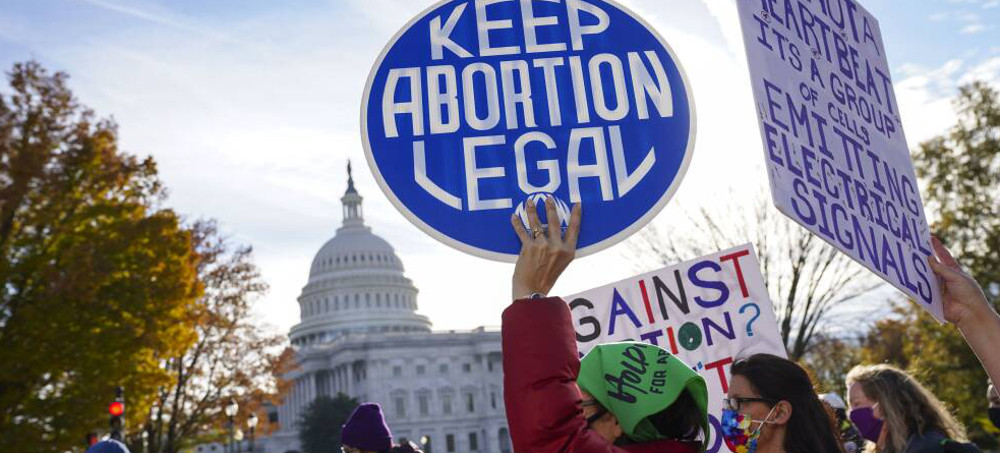 Participants hold signs during the Women's March "Hold The Line For Abortion Justice" at the U.S. Supreme Court on December 1, 2021, in Washington, D.C. (photo: Leigh Vogel/Getty)
Participants hold signs during the Women's March "Hold The Line For Abortion Justice" at the U.S. Supreme Court on December 1, 2021, in Washington, D.C. (photo: Leigh Vogel/Getty)
The anti-abortion side has monopolized arguments based on religion. But some say their faith supports the right to choose
That’s when she found out she was pregnant. Sanders took misoprostol and mifepristone, the two drugs known collectively as the abortion pill, to end the pregnancy.
The decision, she says, was deeply entwined with her religious beliefs, which include respecting full bodily autonomy and caring for other people – core beliefs of Unitarian Universalism, which she practices.
“The only decision that I could make, as a loving mother, was to focus on mothering this child that I brought into the world and terminating this new pregnancy,” Sanders said. “It was absolutely the right decision.”
But Sanders now lives in Georgia, which could pass restrictions on abortion after six weeks of pregnancy if Roe v Wade is overturned in the coming weeks.
Reproductive rights are under threat in the US as states implement harsher restrictions and the supreme court weighs a case that is widely expected to reverse the constitutional right to abortion.
But while religious arguments around the issue are commonly associated with the anti-abortion movement, abortion restrictions can violate the right to religious liberty, faith leaders and legal experts say. And some organizations are already gearing up for possible legal challenges to looming abortion bans.
Religious liberty for people of all faiths is protected under the US constitution, state constitutions and federal statutes.
In Judaism, abortion is usually seen as permissible and even required in cases where the patient’s life is at risk. In Islam, scholars contend that abortion is allowed for the first 120 days, after which it’s seen as a civil – not a criminal – issue, and it’s permitted at any time when the health of the mother is in danger. Other believers, including within Christianity, focus on the sacredness of the individual or the family to make such decisions, rather than prosecutors or lawmakers.
Personal beliefs can even contravene the dictums of established religions; for instance, Catholics for Choice believe they have a religious duty to protect reproductive health despite the Catholic church’s stance against abortion.
Nearly half of Protestants and 56% of Catholics believe abortion should be legal in some or all cases, according to a Pew Research survey published in May. More than half of Muslims, 82% of Buddhists and 83% of Jews believe the same, according to a different Pew study from 2014.
“You don’t have to be a member of an organized religion,” said Katherine Franke, a professor of law at Columbia University and the faculty director of the Law, Rights, and Religion Project. “Your religious beliefs could be your own idiosyncratic beliefs. They have to just be religious to you.”
With abortion bans, some clergy object to what they see as a “Christian theocratic imposition on entire swaths of our country”, as Rabbi Danya Ruttenberg, scholar-in-residence at the National Council of Jewish Women, put it.
“There are very serious religious liberty questions here,” Ruttenberg said. “If you ban abortion, when my religious tradition tells me that I am a) permitted and b) possibly required to access abortion care, you are limiting my free exercise of religion.”
The same questions arise in other faiths.
“In the Muslim tradition, scholars from the medieval time had taken the position that until a fetus is ensouled, it is not a life,” said Abed Awad, a lawyer and commentator on Islamic law.
“A Muslim woman living in Texas, or living in Alabama, who has a sincerely and genuinely held religious belief that in her tradition, she can terminate her pregnancy and it is not a violation of her religious requirements or theology up to 120 days, is going to be prevented from exercising her religious right to control her reproductive health,” Awad continued.
The first amendment has two components to protecting religious rights: first, the state can’t substantially burden the free exercise of religion, and second, the establishment clause prohibits the government from endorsing some forms of religion and condemning others, or embracing faith-based perspectives on public policy.
For example, if states adopt laws on fetal personhood, which would recognize fertilized eggs as people, those laws could violate the establishment clause, because such a view hews closely to Catholicism but not to other religious beliefs on ensoulment and personhood.
Legal challenges on the basis of religious liberty could be “the next stage of reproductive rights”, Awad said, and the National Council of Jewish Women is exploring the possibility of such a challenge, Ruttenberg said.
“Our tradition not only permits us to access abortion but also commands us to pursue justice,” she said. “We, as a religious minority with a long and complicated history, know all too well that the separation of church and state is one of the great gifts that our constitution offers. And it is critical that it be taken seriously.”
There is precedent for people with sincerely held religious beliefs fighting against criminal charges for actions that violate the law.
Scott Warren, a humanitarian aid worker for No More Deaths, successfully argued that his work helping migrants crossing the US-Mexico border was in line with his religious beliefs about helping others, and he was acquitted of federal charges in 2019.
Religious leaders or adherents may feel compelled by their beliefs to provide care, funds, transportation, housing or counseling around abortion, Franke said. “It’s not a stretch to see the work that they do in this area as part of a ministry.”
Sanders, who is now a minister, feels compelled by her beliefs to support access to reproductive healthcare, and she’s now preparing to offer support however she can. “I have a spare room, and I’m in the middle of sprucing it up right now with exactly that in mind.”
Sanders is particularly concerned about the ways restrictions on reproductive rights and trans rights are growing and intersecting. “It’s so terrifying,” she said. She believes it is “an egregious sin” to cause harm to someone by denying them healthcare or human rights.
“We, as Unitarian Universalists, believe fully that all human beings should have bodily autonomy, and anything that happens in or to my body should be my choice,” she said.
“To me, the law of the land and [religious] law are two separate and distinct things. It’s great when they overlap. And when they don’t, I’m going to choose morality over the law every time. And for me, that includes helping people in whatever way I can, for whatever reason they are seeking abortion.”
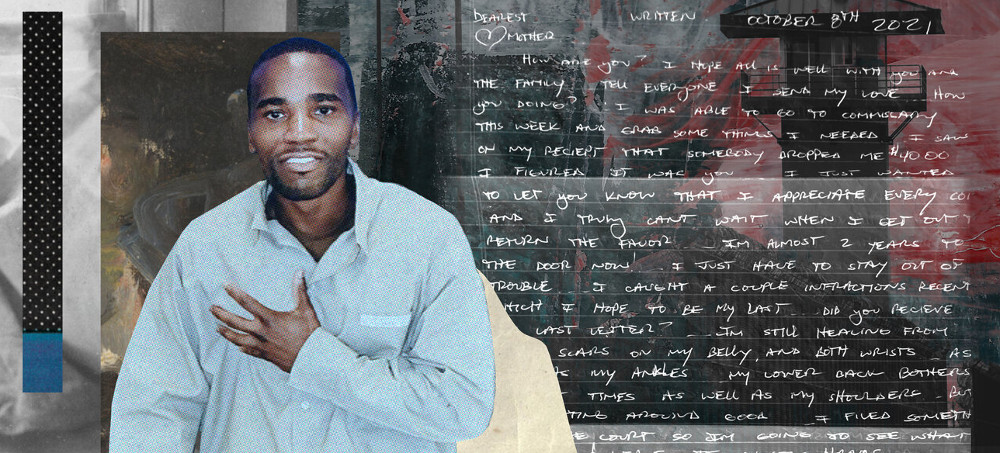 Bobby Everson and a letter he wrote to his family while he was incarcerated in the Special Management Unit at the new U.S. penitentiary in Thomson, Illinois. (photo: Aaron Marin/NPR)
Bobby Everson and a letter he wrote to his family while he was incarcerated in the Special Management Unit at the new U.S. penitentiary in Thomson, Illinois. (photo: Aaron Marin/NPR)
In July 2021, he was sent to the Special Management Unit at the new U.S. penitentiary in Thomson, Ill. — a program meant for some of the most violent and disruptive prisoners, though many have ended up there who don't fit that description. Everson, who was serving time for drug and weapon charges, had recently been written up for "threatening bodily harm" and "assault without serious injury," though prison records don't provide details. After his transfer, his letters home to his family in New York grew more desperate with each passing week.
Everson, who the family called AJ, told them he was locked down nearly 24 hours a day with a cellmate, in cells so small that the toilet was crammed next to the bottom bunk. He was let out only for occasional medical appointments, showers or an hour of exercise in an outdoor cage. He could hear guards in riot gear blasting men on his tier with pepper spray and locking them in hard restraints. His own wrists, ankles and abdomen were scarred from these shackles — prisoners called it the "Thomson tattoo," according to attorneys.
But the most pressing threat came from the men officers chose to put in his cell. "I feel the staff here is purposefully trying to put me in situations of conflict," he wrote to his cousin Roosevelt Murray in late October. "Pray for your lil cousin, man, that I get through this unscathed."
In late November, Everson got in a fight with his new cellmate. "I'm doing my best to bob and weave these incidents," he wrote. "Keep calling up here, inquiring on me any lil free time you get."
Seventeen days later, Everson, 36, was found dead in his cell. It was a homicide caused by "blunt trauma" with an object, according to prison records. Federal prosecutors have yet to file charges against anyone in connection to his death, which is still under investigation.
"I was scared for him, because we don't know what happens in that prison," said Everson's father, Bobby. "When you get up in the morning and know he's not going to be here ... I just miss AJ."
Officials claimed that opening Thomson would make federal prisons safer by relieving dangerous overcrowding. But an investigation by The Marshall Project and NPR found that the newest U.S. penitentiary has quickly become one of the deadliest, with five suspected homicides and two alleged suicides since 2019.
"It's beyond egregious," said Jack Donson, a corrections consultant and former Federal Bureau of Prisons official. "When you look at the policy and goals of the Special Management Unit, it blows my mind that there was [even] one homicide."
The Marshall Project and NPR obtained federal prison data and agency documents, reviewed criminal and civil court cases, and interviewed dozens of people with knowledge of Thomson. In stories that echoed with the same visceral details, dozens of men said they lived under the pressing threat of violence from cellmates as well as brutality at the hands of staff. Specifically, many men reported being shackled in cuffs so tight they left scars, or being "four-pointed" and chained by each limb to a bed for hours, far beyond what happens at other prisons and in violation of bureau policy and federal regulations.
Most people in the Special Management Unit are housed in double-celled solitary confinement — almost constant lockdown with another person. The Bureau of Prisons has said double-celling "mitigates suicide risks." But psychologists and prisoners say living in such claustrophobic conditions with another person can be even worse than being alone and often leads to violent outbursts.
Multiple people claimed in federal court filings that officers stoked tensions between cellmates and intentionally paired men who they knew would attack each other. One person formerly incarcerated at Thomson said in a lawsuit that officers spread the false information that he was a sex offender, inciting physical and sexual assault from multiple cellmates.
The Marshall Project and NPR asked the Bureau of Prisons about multiple lawsuits and claims made in federal court filings out of Thomson, but agency spokesperson Scott Taylor said in an email that he could not comment on pending litigation or individual cases. He noted that people in federal prisons are not housed in "solitary confinement," because "in general, inmates in restricted housing are housed two to a cell." To ensure safety, a team of prison officials consider gang affiliation, religion, geography and past incident reports and complaints when assigning cellmates. Intentionally ignoring a known threat from a cellmate would be misconduct by an officer and investigated, Taylor wrote.
The Bureau of Prisons' Special Management Unit used to be housed inside the U.S. penitentiary in Lewisburg, Pa. — a notorious, nearly century-old prison known as "The Big House." A 2016 Marshall Project and NPR investigation found Lewisburg had been sued multiple times over the high rate of violence among cellmates and the use of harsh restraints by staff. In 2018, the Bureau of Prisons announced it was moving the unit to Thomson.
According to lawsuits, letters and interviews, the violence and abuse at Lewisburg simply relocated to the new facility. The Washington Lawyers' Committee for Civil Rights and Urban Affairs, a legal nonprofit, has spoken to dozens of men at Thomson, many of whom said conditions there were worse than at any other federal prison — including Lewisburg.
"They're literally afraid for their lives," said Jacqueline Kutnik-Bauder, deputy legal director of the committee, which had previously sued Lewisburg over a lack of mental health care. "[But] if they refuse to be celled with a person who they think could kill them ... they get pulled out of the cell and put into restraints as a punishment."
Kutnik-Bauder has heard similar descriptions of shackling from numerous people held at Thomson. "They're having their arms and their legs stretched out and held, separated, for hours and sometimes for days on end," she said. "They are denied food. They are denied water. Many of them report being left in their own waste. It's really akin to a torture chamber."
According to Bureau of Prisons policy and federal regulations, such severe restraints should be used only as a "last alternative" for people in prison who are actively dangerous to themselves or others, and only for as long as it takes to subdue and control the person. "Force may not be used to punish an inmate," the policy states.
"Generally speaking, per BOP policy, restraints are not used as a method of punishing an inmate or in any manner which restricts blood circulation or obstructs the inmate's airways or in a manner that causes unnecessary physical pain or extreme discomfort," Taylor, the bureau spokesman, wrote in an email. "Allegations of staff misconduct are taken seriously by BOP and are referred for investigation to the Office of the Inspector General."
Federal prisons across the country are facing growing scrutiny over outbreaks of violence and abuse by officers, as documented by The Associated Press. And understaffing at many prisons escalated to crisis levels during the pandemic, increasing risks for staff and incarcerated people alike. In response, the Senate has formed a new group to investigate federal prison operations, and Bureau of Prisons Director Michael Carvajal announced his resignation in January. But there's been little national attention paid so far to the ongoing violence at Thomson.
"He didn't deserve to die"
On March 2, 2020, officers put Matthew Phillips — a 31-year-old Jewish man with a large Star of David tattooed on his chest — in a recreation cage with two known members of a white supremacist gang, according to a federal court indictment. The gang members beat and kicked him until he went unconscious. Officers yelled at the men to stop, the indictment says. This wasn't the first time Phillips had been targeted — he was previously attacked by gang members at Thomson and another prison, according to claims made in a lawsuit.
Phillips' parents flew from Texas to a hospital in Iowa, where their son was unconscious and handcuffed to his hospital bed. They had to visit one at a time, limited to 10 minutes, with a guard in the room and two guards outside.
According to information from a Bureau of Prisons internal affairs report shared with The Marshall Project and NPR, officers laughed and made jokes at Phillips' expense, prompting hospital staff to complain about their conduct.
Phillips died three days later, as he neared the end of his seven-year sentence for drug possession with intent to distribute and money laundering.
"It was a long horrible journey that ended in the worst possible way, a death with no degree of dignity at all," said Phillips' mother, Sue. When she flew home from Iowa, her son's last letter was waiting in her mailbox. "I don't think I'll ever recover from it. The Bureau of Prisons doesn't care about the damage they leave in their wake. He didn't deserve to die; he deserved to come home."
In December 2021, federal prosecutors in Illinois charged the two gang members with committing a hate crime and murder. They both pleaded not guilty and face up to a life sentence if convicted. And this February, the Phillips family filed a federal lawsuit, suing the bureau for failing to prevent Matthew's death.
Bureau spokesperson Taylor said he could not comment on the family's ongoing lawsuit. "We can say, however, that BOP is cooperating fully with the investigation and prosecution related to the incident to ensure that justice is served," he wrote.
After Phillips was killed, the violence at Thomson continued.
In November 2020, Edsel Aaron Badoni, a 37-year-old member of the Navajo Nation, died from stab wounds after a fight with another prisoner.
Boyd Weekley, a 49-year-old man from South Dakota, died less than a week later by hanging, according to prison records. (Weekley was the only person to die in Thomson's general population and not the Special Management Unit, according to prison officials.)
Roughly two weeks after that, Patrick Bacon, 36, of Washington state died by suicide, according to an autopsy.
In February 2021, 41-year-old Shay Paniry of California was stabbed to death.
Bobby Everson was killed in December 2021.
And then in March 2022, James Everett, a 35-year-old man from Kansas City, Mo., was found dead. The Bureau of Prisons confirmed in an email that his death was a suspected homicide. A death certificate and autopsy have not been released.
"I think that's what bothers me the most. You send somebody's child home, and you don't even tell them what happened to them," said Everett's father, James. When the family received the body, there were scars on his son's wrists. "It's like, 'Here he is, go bury him.' He had written letters that they were trying to kill him."
There were at least 167 recorded assaults at Thomson between January 2019 and October 2021, according to data provided by the bureau. But this is an undercount, as it doesn't include more serious incidents or deaths that were dealt with outside the prison disciplinary system.
Legislators said the violence is in part due to persistent understaffing. Congress members from Illinois appealed to the Bureau of Prisons in 2021 for worker retention bonuses, writing that the deaths at Thomson "may have been prevented with additional staff."
Officials have struggled to lure enough officers to Thomson, a village of under 1,000 people, especially amid a nationwide prison staff shortage and a hiring freeze under former President Donald Trump. In May 2021, over 30% of the prison's correctional officer jobs were unfilled, according to a letter by union officials. Staff, from counselors to cooks, were regularly conscripted to work as guards. (As of May 2022, prison officials report that 78% of corrections officer positions at Thomson are filled.)
"USP Thomson is experiencing a staffing crisis, bar none in the Bureau of Prisons," said Jonathan Zumkehr, president of Local 4070 of the American Federation of Government Employees, in 2021. "The conditions witnessed at USP Thomson, without immediate intervention, have cultivated an environment with catastrophic potential."
A new location in Illinois
The Thomson facility was built in 2001 by the Illinois Department of Corrections. But it sat vacant for years until the federal government bought the complex, at the urging of Illinois Congress members. Lawmakers said it would create more than a thousand jobs and bring in millions of dollars for local businesses.
"Communities across our region of Illinois have spent over a decade thirsting for today's great news," Rep. Cheri Bustos, a Democrat from Illinois, said in 2014 of moves to open the prison. Illinois Democratic Sen. Dick Durbin called it "a significant investment in the economic future of northern Illinois."
At the same time, Durbin was positioning himself as a critic of solitary confinement. "I have told the Bureau of Prisons to make sure that we're learning lessons about humane treatment that is not going to endanger the inmate's life," he said of the new facility in a 2015 interview with The Marshall Project and NPR. Of double-celled segregation, "I hope we don't see that at Thomson," he said. "I believe it's dangerous."
President Barack Obama initially considered housing Guantánamo detainees at the building in Thomson. But in June 2018, Bureau of Prisons officials announced they were moving the Special Management Unit from Lewisburg to Thomson. The move was to increase capacity, according to Taylor, the bureau spokesperson.
Meanwhile, the bureau was fighting a decade-long legal battle against one man incarcerated at Lewisburg. In 2011, Sebastian Richardson sued the prison, claiming he had been left in painful restraints for nearly a month, in retaliation for refusing to cell with a man who had assaulted multiple cellmates. The chains were so restrictive he was forced to sleep on the floor, Richardson said in a deposition, shoving toilet paper into his ears and nostrils to keep out bugs. Richardson's attorneys tried to file a class-action lawsuit, citing the widespread practice of chaining up prisoners.
An April 2018 report by an agency that oversees prison conditions confirmed that multiple men in the Special Management Unit at Lewisburg were being chained and shackled, sometimes for days. Two men set themselves on fire in protest of the brutal conditions and were then forced into restraints, multiple prisoners told auditors. (In an email, Taylor said the men had set their belongings, not themselves, on fire "in an attempt to have staff open their cell door while they were unrestrained" and assault officers. "It was determined the staff response was appropriate," he wrote.)
But when officials announced the unit was moving to Illinois, the court ruled that the class-action claims were moot, as the Special Management Unit was no longer in Pennsylvania. The Bureau of Prisons settled the individual lawsuit with Richardson this February for an undisclosed amount. More than a decade after leaving Lewisburg, Richardson said in a recent interview that he still suffers searing pain, swelling and numbness in his hands.
Some advocates for men at Lewisburg hoped a new facility would mean better conditions. But not long after the Special Management Unit opened at Thomson, incarcerated people started writing letters making familiar claims of abuse, and local news reported as more men were killed.
In an emailed statement this week, Sen. Durbin, who is chair of the Senate Judiciary Committee and part of a Senate group working to strengthen prison oversight, called the deaths at Thomson "unacceptable" and said he was pushing for a "reform-minded" leader to head the Bureau of Prisons. Durbin called for agency director Carvajal's resignation in November.
"For many years, I have sounded the alarm on BOP's widespread failings," he wrote. "It's disappointing that the BOP has yet to fully address its staffing crisis and take the steps necessary to improve conditions of confinement and end the overuse of restricted housing throughout all of its facilities, including Thomson."
Heather Sager, a spokesperson for Rep. Bustos, said in an email that Bustos would keep pushing to ensure that Thomson had the "resources and staffing necessary to help keep staff and those incarcerated safe."
Some at Thomson call it "the dungeon"
At Thomson, some call it "the dungeon" or "the torture room." It's where men say they are locked in hand and ankle cuffs so tight they leave scars and nerve damage, according to filings made in federal court. Others claimed in lawsuits that they were four-pointed, spread-eagle and immobile, for hours at a time. Several have claimed in legal filings that they were put in paper clothes, denied food and water, and forced to lie in their own urine and feces.
Multiple men incarcerated at Thomson said officers would fabricate reasons to justify restraining them, writing on internal forms that they were making threats or slipped their hands out of cuffs and hit a guard.
"To be chained down inside of an ice cold cell where the restraints are cutting into your flesh, forced to defecate and urinate on yourself ... is torture," one man incarcerated at Thomson wrote in a letter to reporters.
Bureau spokesperson Taylor said any allegations of abuse of force were taken seriously and investigated.
The bureau did not provide data on the use of restraints at Thomson. But it did provide data on how many times officers there deployed emergency pepper spray: at least 231 times between January 2019 and August 2020 (the most recent data provided) — 72 more incidents than the second-highest-use facility.
One man who sued the prison as "John Doe" claimed that officers mislabeled him a sex offender and told the other prisoners to "clean up their car," meaning get rid of the sex offenders and snitches in their unit. According to his lawsuit, when Doe tried to avoid returning to his cell out of fear, he was pepper-sprayed and shackled by guards. Officers then chained him down to a concrete bed, beat his body and genitals with shields and left him there through the night, according to his court filing.
"This sort of extended physical and psychological torture caused the Plaintiff physical pain and suffering, and extreme, permanent mental anguish," the complaint states.
After he was returned to his cell, Doe was repeatedly attacked by his cellmate. Desperate for help, he slipped a note about his blood pressure to a nurse, sneaking in tiny print, "please help me, I'm being sexually assaulted." Even after that person was moved, Doe was beaten by his next two cellmates, according to his legal complaint.
"I've seen a lot of things, and I had never heard of something like this," said Richard Dvorak, a civil rights attorney in the Chicago area who has taken on Doe's case, along with another lawsuit out of Thomson. Doe has since been moved to another prison.
The Bureau of Prisons has until July to respond to the lawsuit in court.
A spokesperson for the Justice Department said in a separate statement that the department was "equally committed to ensuring that the Bureau of Prisons can meet its dual mission of 1) providing safe, secure, humane conditions for individuals in their custody and 2) doing everything they can to properly prepare individuals for a return to society."
"He was a victim of staff and prisoners alike"
In December 2021, a Thomson prisoner named Demetrius Hill wrote a letter to the federal judge in Illinois, filed as part of his own lawsuit, about the man in a nearby cell. He had been writing regularly to the court to bring attention to what was happening at the penitentiary. "Between 10:00 and 10:47 pm the prisoner in cell F3-13 was brought out of his cell and placed on a stretcher, having blood all over his face and completely unconscious," he wrote.
The man on the stretcher was Bobby Everson. Hill wrote in a letter to reporters that Everson, who was about 5 feet, 6 inches tall, had been housed with a much bigger man who had assaulted multiple previous cellmates.
"He was murdered in the SMU, forced into the cell with a raving lunatic who told the CO unit team over and over again that he'd kill him," Hill wrote in another federal court filing. "He was a victim of staff and prisoners alike, the same prisoner who was put in chains, repeatedly slapped in the face, picked up and slammed, and had gas sprayed in his face."
The man who Hill claims killed Everson has not been charged in Everson's death. But that man had been writing his own federal legal complaints and motions, claiming he had been beaten by guards while in hard restraints, assaulted by past cellmates, denied his medication, and previously housed with men who officers knew were dangerous.
"I am tired of fighting people," Everson's cellmate wrote, a month before Everson's death.
Bureau spokesperson Taylor said he couldn't discuss Everson's death because it was still under investigation. He reiterated that allegations of employee misconduct are referred to the Office of the Inspector General. If someone in prison has a "security concern," he wrote, they can tell the officers on their unit or file an administrative remedy and ask to be moved.
Five months after Bobby's death, the Everson family had not received his death certificate or an autopsy report. They did receive a phone call and a pamphlet from the FBI, which said the agency was investigating Everson's death. (Federal prosecutors have not filed charges, and an FBI official told reporters they could not discuss the case.) The family was mailed a box of his belongings, including handwritten rap lyrics, a Bible, deodorant and two self-help books. And they received his body — bruised and scarred — though they weren't given enough financial support to bury him as they wanted. They had to cremate him instead.
Now there are memorials to Everson scattered throughout his sister Ebony's house: a sketch of Bobby drawn by his cousin, a poster-size photo collage with pictures of him at a Rick Ross concert, the program for his funeral lined up on the windowsill. Before he died, Everson wrote about how he was excited to move home to New York, reconnect with family, pursue his rap career and get a job as a truck driver.
The family has been through this before. One of Everson's cousins died in a New York state prison in 2005, when he was 20 years old. His death was ruled a suicide, but his mother, Angela Everson, doesn't believe it.
"I think you grieve longer and harder because you don't know [what happened], but you can imagine," Angela Everson said. "My boys were not the only ones killed by the prison, and they won't be the last. It's a pain that just don't go away."
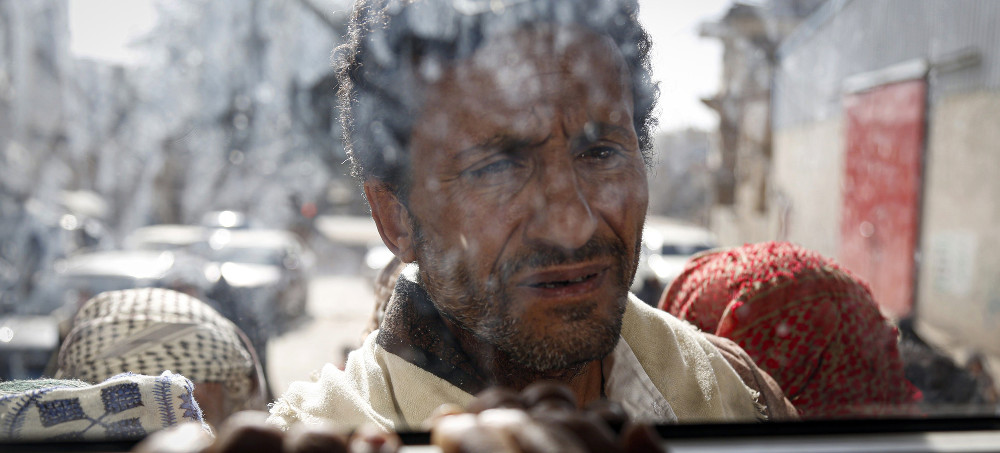 A man affected by war waits to receive free meals provided by a charitable kitchen in Sana'a, Yemen, on April 03, 2022. (photo: Mohammed Hamoud/Getty)
A man affected by war waits to receive free meals provided by a charitable kitchen in Sana'a, Yemen, on April 03, 2022. (photo: Mohammed Hamoud/Getty)
Proponents have passed similar bills before, but this time they’ll have to contend with a White House striving to rekindle relations with Saudi Arabia.
During the Trump administration, some Democrats, joined by a handful of Republicans, fought to end the U.S. bomb sales, intelligence support, and warplane refueling that made the Saudi intervention possible. But with a Riyadh-friendly president in the White House, their efforts never had a plausible chance of actually forcing the kingdom to withdraw. Democrats at the time didn’t bear responsibility for managing relations with a major weapons customer and oil producer that helped keep gas prices low at home. In early 2019, when majorities in both the House of Representatives and Senate for the first time in history invoked the 1973 War Powers Resolution to end U.S. involvement, Saudi Arabia could rely on former President Donald Trump’s veto.
So the war dragged on. President Joe Biden adjusted U.S. policy when he entered office by demanding an end to “offensive” support, but this didn’t have a material impact for Yemenis trapped by the blockade and Saudi air raids supporting it. In November, the United Nations estimated that 377,000 Yemenis would be dead by the end of 2021, 70 percent of whom would be children, many as a result of starvation and disease. According to the World Food Programme, more than 17 million Yemenis are battling food insecurity, and that figure is expected to rise to 19 million, or nearly one-third of the population, by December 2022. Two months ago, the U.N. brokered a cease-fire between Saudi Arabia and the Houthis that gave the population some respite, but it’s scheduled to end this week. Numerous aid groups are calling for an extension.
With the deadline looming, Rep. Peter DeFazio, D-Ore., co-founder of the Congressional Progressive Caucus, introduced a new resolution on May 31 invoking the 1973 War Powers Resolution to demand that Biden end U.S. military participation in the Yemen war. According to a press release from the CPC, Sen. Bernie Sanders, I-Vt., will introduce a companion resolution when the Senate is back in session.
“It’s particularly timely now because the truce between the Saudi-led forces and the Houthi-led forces expires on the 2nd of June and we don’t know exactly what will occur — it could be renewed — and we’re hoping that this will be a little prod toward renewal,” DeFazio told The Intercept in an interview.
“It’s essentially a proxy war between Iran and Saudi Arabia unfortunately being carried out in Yemen and leading to hundreds of thousands of civilian deaths in Yemen and a huge humanitarian and ongoing humanitarian crisis,” he added. “This cease-fire has given some temporary relief, and I would hope it would continue.”
Forty-one Democrats and Republicans have signed on as co-sponsors, including CPC Chair Pramila Jayapal, D-Wash., and Rep. Ro Khanna, D-Calif., who introduced an earlier version in 2019. DeFazio also secured the support of more moderate Democratic leaders, like House Permanent Select Committee on Intelligence Chair Adam Schiff, D-Calif., and House Rules Committee Chair Jim McGovern, D-Mass., whose panel will have to shuffle the resolution through to a floor vote. There are five Republican co-sponsors: Reps. Nancy Mace, R-S.C.; Thomas Massie, R-Ky.; Ken Buck, R-Colo.; Matt Gaetz, R-Fla.; and Andy Biggs, R-Ariz.
And the resolution has the endorsement of more than 100 organizations, including the Friends Committee on National Legislation, Demand Progress, and Just Foreign Policy, which are urging members of Congress this week to support it. “This is more essential than ever to maintain momentum for the fragile two-month truce and to prevent backsliding by blocking U.S. support for any renewed hostilities,” their letter, shared with The Intercept, says.
“Congress has a historic opportunity to end crucial U.S. engagement in the Saudi-UAE-led coalition’s deadly and inhumane war against Yemen, and reclaim their Constitutional jurisdiction over war,” Cavan Kharrazian, foreign policy campaigner at Demand Progress, wrote in a statement.
While proponents now have more of a Saudi skeptic in the White House than during their previous attempt at invoking the War Powers Resolution three years ago, passing the resolution again today may be a heavier political lift. U.S. relations with Saudi Arabia are at a crossroads: After initially promising to isolate the crown prince, Biden is now trying to curry favor with him.
In 2019, invigorated Democrats rode on their newfound control of the House to challenge the Trump administration, whose unapologetic allegiance to Saudi Arabia infuriated members of both parties. Trump had come to Crown Prince Mohammed’s defense after the murder and dismemberment of journalist Jamal Khashoggi in October 2018, just a few months after Saudi Arabia bombed a school bus in Yemen, killing at least 26 children. In November 2018, the White House relented somewhat by agreeing to no longer refuel Saudi coalition warplanes — Riyadh said it did not need U.S. support anyway — but Washington still supplied weapons, logistical support, and intelligence that allowed the war to continue.
Biden looked to make a change, pledging on the presidential campaign trail to make Saudi Arabia a “pariah” and removing the Houthis from the State Department’s terrorist list upon entering the White House.
“This war has to end,” Biden said in his first foreign policy speech as president, in February 2021. “And to underscore our commitment, we are ending all American support for offensive operations in the war in Yemen, including relevant arms sales.” The White House put a halt on hundreds of millions of dollars’ worth of bomb sales but has still enabled U.S. maintenance of Saudi warplanes conducting airstrikes in Yemen. Biden also did not demand an immediate end to port blockades.
Although the White House allowed Saudi Arabia’s war to continue, Riyadh has strong-armed Washington by refusing to increase oil production, driving gas prices in the U.S. to record highs, with frustrated voters set to cast ballots in this year’s midterm elections. Facing low approval ratings at home, in part a result of higher energy costs, the White House is now trying to rekindle the relationship and even discussing an extension of Trump’s Abraham Accords to Saudi Arabia. Passage of a new resolution to end U.S. military involvement in the Yemen war may upset those efforts.
And some Democrats’ positions have softened over the years. Sen. Chris Murphy, D-Conn., once one of the Senate’s strongest advocates for ceasing U.S. participation, voted in favor of a $650 million missile sale to Saudi Arabia in December. The State Department claimed that the weapon was “defensive.” And House Armed Services Committee Chair Adam Smith, D-Wash., an original co-sponsor of the 2019 resolution invoking the War Powers Resolution, is not an original co-sponsor now. Smith told The Intercept last month that he was undecided on whether to back it, wanting to review the final language and speak with the White House first. “I think the Biden administration is really committed to putting pressure on all sides,” he said.
Some lawmakers may hesitate because this year’s bill goes much further to cease U.S. military support than the 2019 version. Then, the bill narrowly focused on ending midair refueling of Saudi warplanes and included an amendment, offered by Buck, the Republican representative from Colorado, clarifying that intelligence sharing may continue. The new resolution would forbid logistical and maintenance support for warplanes bombing Houthi targets, coordination with Saudi-led military forces fighting the Houthis, and intelligence sharing. The expanded bill has Buck’s support, but it has lost many original co-sponsors; in 2019, the resolution had about 70 original co-sponsors in the House, including House Majority Leader Steny Hoyer, D-Md., who is not on the list today.
Hassan El-Tayyab, legislative director for Middle East policy at the Friends Committee on National Legislation, acknowledged the challenges ahead. “FCNL and our allies, on and off the Hill, are ready for a more difficult political fight on the Yemen War Powers Resolution this time around. In 2019, Democrats were eager to push back against President Trump. Now, many are hoping President Biden normalizes relations with Saudi Arabia to lower energy costs,” he told The Intercept.
“As Biden is preparing to head to the region to potentially formalize a security arrangement with Saudi Arabia, this War Powers Resolution sends a strong signal from Congress that any agreement with the kingdom needs to include ending war in Yemen,” he added. “By reasserting its Article I war authority, Congress can help extend the temporary Yemen truce into a lasting peace settlement and finally bring this devastating humanitarian crisis to an end.”
 The study released by Science Advances says at least 1,000 species could benefit from protecting 30% of global lands by 2030. (photo: WWF)
The study released by Science Advances says at least 1,000 species could benefit from protecting 30% of global lands by 2030. (photo: WWF)
Land protection can also regulate water quality and mitigate nutrient pollution.
If countries succeed in protecting 30% of global land area by 2030, it could benefit about 1,000 vertebrate species whose habitats currently lack any form of protection, according to a study published Wednesday in Science Advances.
About half of the species that would benefit from expanding protected areas worldwide are classified as critically endangered, endangered, vulnerable or near-threatened, the scientists said.
What is being dubbed by scientists as the "30 by 30" target could also spare about 11 billion tons of carbon dioxide per year in avoided carbon emissions or carbon sequestration, the paper states.
Researchers from Princeton University and the National University of Singapore compared models that maximize different aspects of conservation. They considered only natural areas and excluding croplands and urban areas, and found that additional benefits could result for biodiversity conservation, climate change mitigation and nutrient-regulation if protected area coverage were increased to 30% of the terrestrial area within 238 countries worldwide.
Yiwen Zeng, an ecologist at Princeton University's Center for Policy Research on Energy and the Environment and author of the study, described 2030 as the "midway point" to "50 by 50," or the goal to protect half of the Earth by 2050.
"The general idea is that we can actually protect over 1,000 species, on average, if we commit to this," he told ABC News. "It can mean a huge part of our climate reductions and sequestration needed to prevent climate change."
In addition, expanding protections to land globally could "greatly" increase the land's ability to regulate water quality and mitigate nutrient pollution, according to the study.
"Since only about 16% of global land area is currently protected, achieving this target will require most countries to rapidly expand their network of protected areas," the study states.
The researchers used a model called "scenario analysis," where they would compare protecting land that contained mostly rock and ice to protecting areas filled with trees and species.
What they found is that "if you can prioritize the maximum number of species, you could save a paradise," Zeng said.
However, the researchers found the "30 by 30" goals may require including habitats owned and managed by indigenous communities, local governments or private entities, or mobilizing payments for ecosystem services, the research suggests.
More than 50 countries, including the U.S., China. Japan and Germany, have pledged to protect 30% of Earth's land and oceans by 2030. The United Nations Biodiversity Conference, COP15, will take place in Kunming, China, on Oct. 1.
Special Coverage: Ukraine, A Historic Resistance
READ MORE
Follow us on facebook and twitter!
PO Box 2043 / Citrus Heights, CA 95611

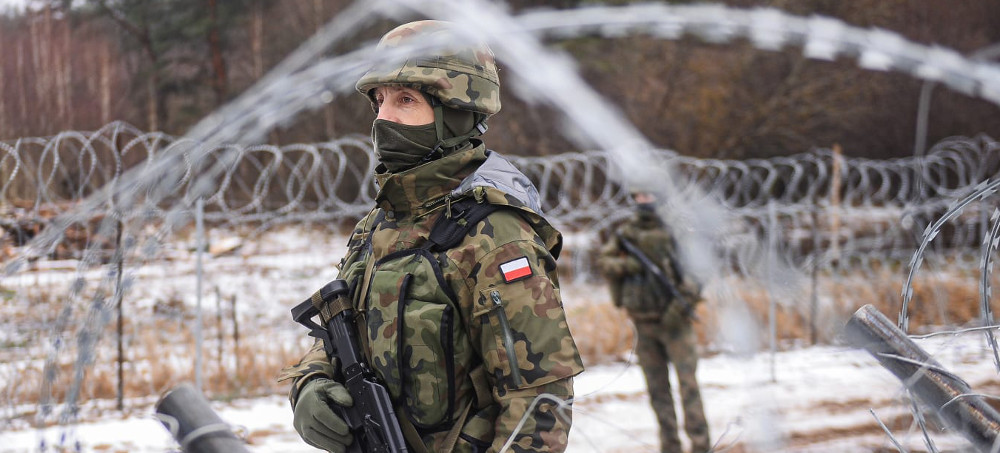

No comments:
Post a Comment
Note: Only a member of this blog may post a comment.